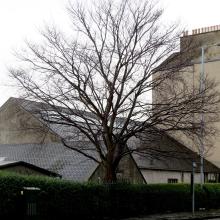
This early-mature tree in the grounds of the Territorial Army garage on East Claremont Street has been diagnosed with Dutch Elm Disease (DED) and needs to be taken down.
Although it hasn’t issued an enforcement order for sanitary felling, the Council strongly recommends this course of action since the owner might be liable for any damages or injuries caused by falling dead branches.
DED is ‘primarily transmitted via elm bark beetles, which breed between the bark and the sapwood of a branch or stem of dead or dying elm trees in a zone known as the vascular cambium,’ explains a CEC Trees Officer.

DED reached Edinburgh in the late 1970s, at which time there were around 35,000 specimens in the city. That figure now stands at fewer than 5,000, but this is still the greatest concentration of the species in Scotland. Readers will remember the sorry losses in Drummond's playground in 2008, 2010, 2012 and 2013 (Breaking news, 16.10.13).
Interestingly, this is not the first time that elms have suffered catastrophic decline in Britain. The trees’ almost complete disappearances from north-western Europe some 6,000 and 3,000 years ago are now thought to have been driven by a mixture of Neolithic felling and Dutch Elm Disease.
One day, they may well return, and in the meantime research continues at the Royal Botanic Garden into innoculating saplings.
-----------------------
 Patrick Hadfield What a shame!
Patrick Hadfield What a shame!
 Graeme Purves That site is really too restricted for a forest tree.
Graeme Purves That site is really too restricted for a forest tree.